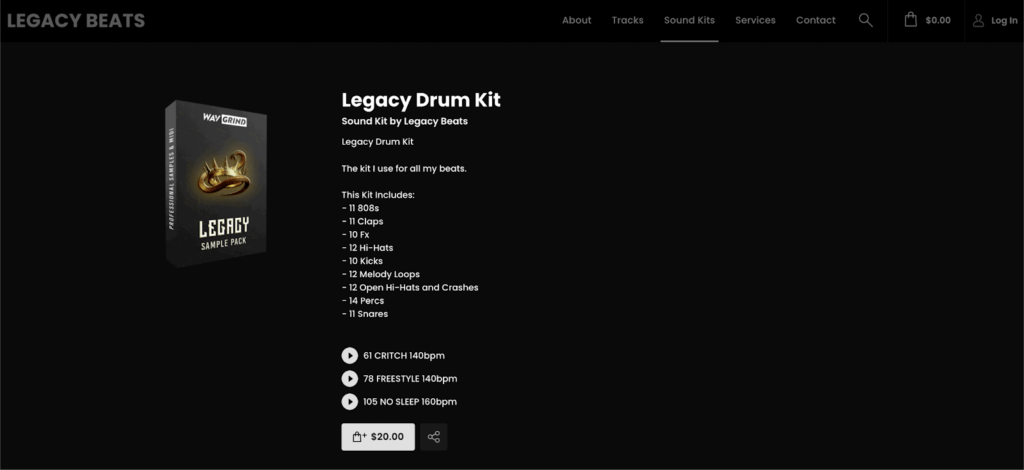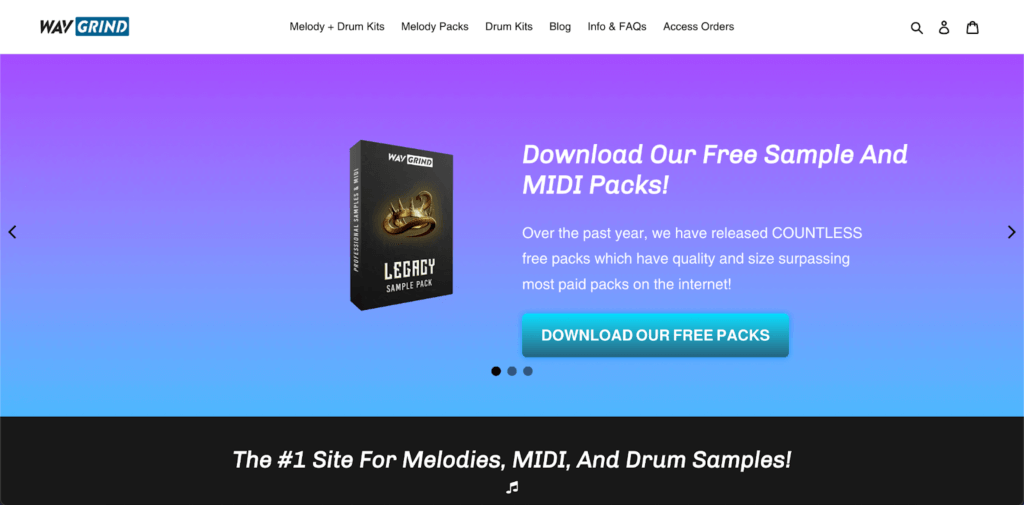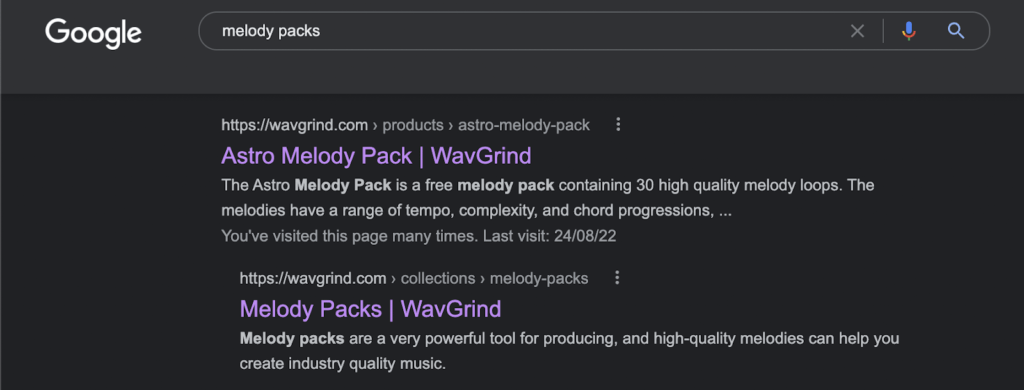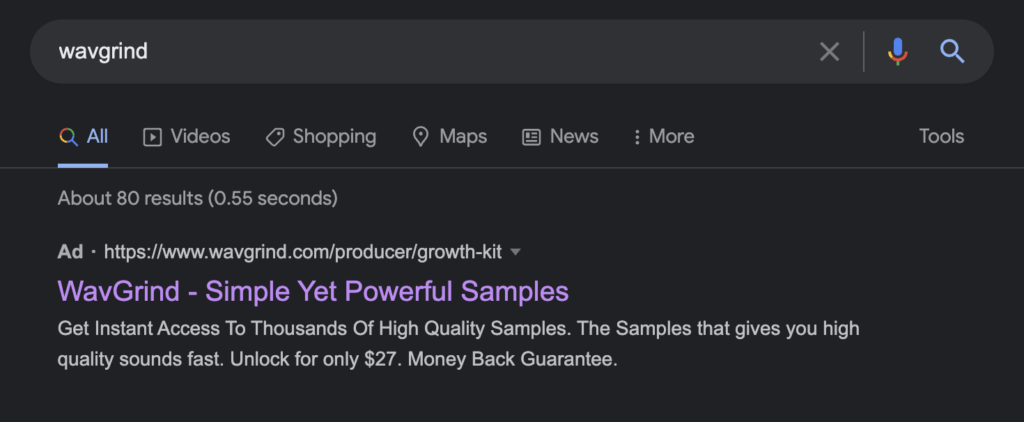
How to Sell Sample Packs Online (examples included)
As a music producer, it’s very important to build up multiple revenue streams and today we are going to talking about one of those – how to sell sample packs online.
Many music producers only focus on selling beats, getting paid off streams, mixing and mastering services, consulting, coaching but selling sample packs is often overlooked or thought of as being too difficult.
Why sell sample packs online?
The sample industry is booming with millions of music producers looking for samples they can use to produce with.
Not all music producers are musicians and those that aren’t need sample packs to make beats.
If you can play an instrument, you might want to think about selling sample packs online to get extra revenue and exposure.
So if you’ve ever thought of putting together a sample pack, or are looking to boost sales on your current sample packs, this is the guide for you.
Who am I?
My name is Luke and I am the founder of WavGrind. I have over 100,000 producers using my sample packs. I’ve built a team of 7 producers who work with me on all of our products, as well as another 20 producers and musicians I’ve worked with on big projects.
So I’d say I’m qualified to teach you how to sell sample packs online.
In a relatively short time, I’ve been able to build our audiences, work with a lot of artists and producers, as well as sell a lot of sample packs.
I’m going to help you uncover the secrets behind growing your audience by putting out sample packs.
You’re only as good as your samples are…
In the music industry, music speaks for itself. This means, if your samples aren’t good, it’s going to be very hard to get people to listen, download, or buy.
Before you even put together a sample pack, compare your sound quality to popular professional packs, and see if your samples would fit in that pack undetected.
It’s likely that your first sample pack isn’t going to be perfect. There’s no point in promoting a product that isn’t of quality so take your time.
The first sample pack I put out was called the Legacy Sample Pack. I spent a lot of time producing and recording samples and melodies to put in the pack. Here are ways you can create drum samples:
- Recording drum samples on a drum kit
- Using software like sublab, tr-808, or Serum
- Recording ambient sounds
- Recording percs by tapping or rubbing together objects in your house/studio
Here are ways you can produce melodies to use in your packs:
- Record melodies on a live instrument
- Use a plugin like Nexus or Omnisphere
- Mix together live melodies and processed melodies
- Export the MIDI of the melody to include in the packs
- Record or generate vocals for your melodies
A good product is more important than good marketing
When your products are that valuable and high quality, people will download and buy very often, and become loyal fans. If you need to spend 4 months working on a pack you’re happy with that can compete with the paid sample packs on the internet, it’s worth it.
As an added bonus, have variety in your packs. You can do this by adding bonus libraries and by splitting your pack into genres. For example, instead of just having one big melody folder, split that folder into trap samples, R&B samples, EDM samples, lo-fi samples, drill samples, etc. You can also add folders with vocals, live instruments, drum loops, MIDI, and more.
All these bonuses add value and make your product superior compared to the rest of the products on the market.
The takeaway from this first section is:
- Make your product AS good as possible. Anything you can do to improve it and make the customer experience better is worth it.
- Add variety to your pack by adding different genres and recourses. Not every producer just wants 1 genre and 1 type of sample pack.
- Make sure your packs can compete with the current popular packs on the internet. Why would someone come to you instead of your competitors?
- Use a mixture of live and processed samples (if possible) to make your samples usable in ALL genres and styles of music.
Market your sample packs correctly and effectively.
There are a lot of different ways to sell sample packs. You can sell them directly to your audience, put them on a product store, put them on a custom website, or build a funnel around them.
Each of them has it’s upsides and downsides, which I learned from trying all of them.
Selling directly to your audience:
This is for beginners who don’t want to put time, effort, or money into building any kind of website. This involves simply using Cashapp, PayPal or Stripe to get people to send you money, in exchange for you sending them your sample pack.
Simply promote your sample pack on your story, by posting about it, and by messaging friends and connections. The upsides are that it’s easy… and that’s pretty much all the upsides.
The downsides are that it’s unprofessional, you can’t show your target customers proper demos, product delivery is manual, and not many people are just going to send you money in hopes you’ll email them a sample pack they haven’t even really heard…
So this isn’t the most ideal way to sell sample packs online.
Automating the delivery of Samples Packs sales
A sample product store:
This could be something like Beatstars or Airbit, where you can build a site on their domain, and host a product page for your sample pack. The benefits are that this is super easy! Simply upload the image, write a little bit of text about it, and add some demos.
It’ll look something like this which I made in Beatstars. You can also make your sound kits free and require people to follow or subscribe to be able to download them.

The benefits are that it’s super easy to set up, Beatstars is cheap, you keep 100% of the revenue, the page looks alright, and it can get some traffic from people visiting Beatstars/Airbit.
The downsides are that there is very limited customization you can do with the page, you can’t add upsells, or cross-sells, and it’s harder to properly optimize for SEO (google rankings).
However, if you don’t intend to release a lot of packs, just a handful to your followers, this can be a very smart option.
Your own eCommerce website:
This is what most serious producers use to sell their sample packs online. These days, you can often do this without having to hire a developer by using a website builder like Shopify, Selfy, or WordPress to build a website on your domain with your sample packs. For example, this is our site:

We have all our sample packs, some free packs, a blog, proper demos, reviews, and more. This is very professional and helps with getting producers to trust you and buy. You can easily build a website on Shopify in under an hour, and start putting your sample packs up.
Another benefit is that since it’ll be on your domain, you’ll be able to write blog posts and drive traffic to your page which will help it rank high on Google. This can get you sales on autopilot.

The downsides are that it’s a lot of time and effort to properly set up, can cost a bit of money, you need at least a handful of sample packs to make it worth the time, and you’ll need to drive all the traffic to the site yourself since it’ll take a long time before Google starts indexing and ranking your pages.
The upsides are that it looks professional, you can upsell and cross-sell other packs. If you rank on Google you’re making free money since you don’t have to advertise. Also, you can put out free packs to collect emails. Plus, it’s easy to have a blog on your site to write helpful articles (like this one). This not only helps you build a relationship with your audience but also helps you rank and get traffic.
For almost every sort of producer, this is the best option. For a select few producers who want to go levels above… this next one may interest you. This one and the next one work together perfectly.
Building a sales funnel around a sample pack offer:
Maybe you’ve seen ads for sample packs, MIDI, packs, plugins, and courses before. Most of the time those would be sending you to a sales page/sales funnel. This is a page, or series of pages with the purpose of selling one product. It doesn’t link to other pages, social media, or blog posts.
The goal is to effectively show the benefits and value of a specific product and increase the number of people who visit the page and actually buy. The previous options have a lot of friction which results in potential customers leaving. A sales funnel reduces all the possible options a user can take down to leaving or buying.
This is an example of a funnel we built for a product called the Producer Growth Kit:

As you can see the navigation bar at the top scrolls users down to reviews, demos, bonuses, FAQs, and the order form. If I was to run ads to the website in the previous example, versus this page here, this page could make 5x-10x the sales because of how effective a dedicated sales page is.
I could probably record a 10-hour course going over how to properly build a successful sales page and product, and I still would barely scratch the surface, so I’ll go over the fundamentals.
You should…
- Make an amazing product, that is competes with other sample packs in terms of value and quality.
- You need reviews on your site. Reach out to customers and users of the pack and get them to film or message you a review. I’d recommend not using fake reviews because it will break the trust between you and your audience.
- You need a lot of demos. If people are going to pay you for this sample pack, they’ll want to be able to hear a lot of demos.
- Record a sales video if possible. In the video, I go over the features of the kit, demos, and bonuses. It helps when people can put a face to the company and it builds trust.
- FAQs (Frequently Asked Questions) are important. What are potential customers asking that isn’t clear on your website? Is your pack royalty free? Is there a money-back guarantee? How will they receive the download?
- Consider adding benefits and “sales copy” to your page. This is text and dot points going over the benefits of the product and how it’s going to help them. This is much more powerful than outlining the features. People want to know how it’s going to help them.
- Optional marketing features include email collection, an abandoned cart sequence, an exit popup, a proof popup, product bumps and upsells, etc.
This is for the 0.1% of producers who have a really good product and want to take things to the next level when it comes to marketing.
This part has the highest effort out of all of the options but also the highest reward.
The downsides are that it’s very hard and expensive to set up. You’ll need to effectively drive traffic to make it worth it. It’s likely you will have to make hundreds of changes to optimize it properly. You only have so much time in the day so it’s a bit of a trade off. With the same time and effort, you probably could have added 15 sample packs to your sample pack store.
Why build a sales funnel to sell sample packs?
The upsides to this when your sales funnels done effectively and hyper-optimized you have the opportunity to run ads to the page and make back the same, or a little more than what you spend on ads.
Doing this, turns your funnel into a customer acquiring machine.
Since it converts so high, it will also make the methods in the next section more profitable.
How to drive traffic to your sample packs, and get sales:
Once you have a store of some sort, next you need people to visit the store and buy.
The methods that cost the least amount of money usually require mass amounts of effort. The methods that cost a lot of money usually do all the work themselves.
I’d recommended for you to start with the free/cheap methods and then work your way to the expensive methods where you can scale.
The methods I’ve had great success with are content, outreach, affiliates, and paid traffic.
Content:
This involves putting out content on social media platforms. This could be YouTube, Instagram, TikTok, Facebook, Twitter, etc. This is essentially free and has almost unlimited potential.
The issue is that its very time-consuming and you’re at the liberty of the platforms that you’re using.
For example, this is a post I made using some samples in a pack of mine.
I made a beat using a sample pack of mine and buit up some hype for the release. I had producers messaging me about it and comments with producers ready for the full pack.
You can do the same thing with TikTok, Facebook, and YouTube shorts.
For YouTube, you’ll need to create longer producer-related videos referencing your product. With Twitter, you’ll need to create text-based content – however, images and videos can still be posted.
Outreach:
This involves reaching out to potential customers. There are many platforms where you can do this, and it can be a powerful way to drive traffic. This could involve sending dms, comments, and emails. The main thing to keep in mind is not to spam. You want to build meaningful connections.
Social media
You can do this on Instagram and other social medias by following, commenting, messaging and supporting other producers. Give them some feedback on a track, congratulate them on an achievement, or start a conversation. When appropriate, drop a link to a pack. To find producers to message, just look on your explore page, your followers, other producers’ followers, etc.
You can also email producers by finding their email on their social media. DON’T add them to an email list but you can shoot them a link to your pack in a single email. You can search “send me samples” on Twitter to find some emails for example.
Disadvantage of these methods
These outreach methods can be effective, and are free, but are extremely time-consuming. It could be a good way to get feedback, test your website, and build your email list.
Affiliates:
Affiliates promote your products for a commission. You don’t need to do any work to get the sale, and the affiliate doesn’t need to build or fulfill any products. I recommend giving affiliates 50% of the revenue that they refer.
You can create affiliate links using Shopify apps, default tools on most funnel builders, or by using Google Tag Manager and making your affiliates their custom links with custom UTM parameters.
You can tell your followers, email list, and customers that they can become an affiliate. Every time you release a new product you can tell your affiliates and a lot of them will start promoting it for you!
Paid traffic:
Paid traffic is a very difficult market due to cost, but can have serious potential. It involves running image or video ads on different platforms linking to your website.

If you didn’t set up a funnel, it’s very likely you will lose money with ads. For example, let’s just say you are getting clicks for $1 (which is very cheap) and pay $100. You will end up with 100 clicks. If you have a $30 sample pack, you will need a 3.33% conversion rate to break even. A 3.33% conversion rate is very high, and a $1 cost per click is very low, so best case scenario you don’t lose a lot of money.
The downside is, if you try and scale and spend $1,000 for example, you will likely be getting clicks at around $2, if not more, therefore making you back only $500. This is with the very optimistic 3.33% conversion rate. The majority of producer sites get a 1% or less conversion rate, lowering revenue down to $150.
As you can see…
If you don’t know what you’re doing it’s very easy to turn $1,000 into $150.
I’ve done it many times when I was starting off.
Summary
Over the past year, I’ve spent about a million dollars on ads with very positive results. Here are my top recommendations for running ads:
- You need a funnel. Make sure you’re running an ad to some sort of sales page where one product is the focus of the page. Running it to a normal website with multiple menus and products is not how you effectively get people to buy.
- Start small. You can spend $5 a day on Facebook while you start to get the feel of it.
- The actual ad is more important than the targeting. As long as you’re targeting producers, a good, interesting ad will get people to click and buy.
- Test a lot of different audiences and ads. The click-through rate is an early indicator of how an ad/audience is performing.
- Optimizing the website you’re sending people to is just as important as optimizing the ads. If people are clicking and not buying, you need to start testing some changes on your website.
- Start with retargeting! You can run ads to people who have watched your videos, visited your page, sent you a dm, went to your website, etc. I’ve found these audiences will always convert the highest because these people are already interested in you.
I hope you learned a lot from this guide!
If you found this information useful, please share it by clicking one of the social share icons below.
~ Luke
